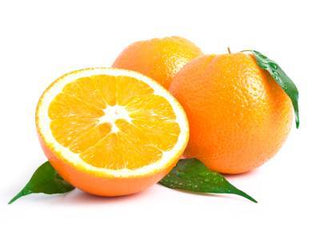(Citrus sinensis)
The legacy of Oranges in the United States can be traced back to the New World’s famous discoverer - the very first oranges were introduced to the Americas by none other than Christopher Columbus. Spain produces a bitter orange, known as the Seville, and Columbus brought these sour oranges with him on his second voyage to the West. Sweet oranges and seedlings followed soon after in the hands of other European settlers.
The fruit of semi-tropical evergreens, oranges are technically a hesperidium, a type of berry. Interestingly, oranges are actually a cultivated hybrid. Most likely a mix between a pomelo and a mandarin, oranges as we now know them were developed some 4,000 years ago in China. Even today, oranges are known in many languages as a “Chinese apple”. Thanks to the moist climate of the American South, oranges flourished in the humidity of Florida and by the end of the Civil War oranges were being shipped north by the crate.
Oranges are members of the citrus family. Varieties include the sweet orange, the sour or bitter orange, and the mandarin orange, or tangerine. Sour oranges are primarily produced in Spain and are used for marmalades and liqueurs. The familiar sweet varieties are produced in the United States.
Fresh oranges are available throughout the year with harvests in Florida, California, Arizona, and Texas. Variety, taste and color vary by climate. Thanks to cool desert nights, oranges grown in California and Arizona tend to be a deeper shade of orange than their East Coast counterparts.
The most well known varieties of sweet orange include the Hamlin, Parson Brown, Valencia, Navel, Jaffa, and Blood. Perhaps the most popular, both the Valencia and the Navel have been cultivated to be seedless. Valencia oranges are commonly used in orange juice. The Blood orange, the sweetest of the oranges, has a deep crimson flesh and a sweetly perfumed rind. Blood oranges are grown seasonally and can be difficult to find even when in season.
Nutrition/Health
Oranges are a healthy food option with a medium fruit containing just 65 calories. Although an orange has 16 grams of carbohydrates, 3 are from fiber which helps to slow the release of glucose into the blood stream.
In the U.S., orange consumption is primarily in the form of orange juice. This is unfortunate as the juice is a concentrated source of sugars, with an 8-ounce serving providing 112 calories, 26 grams of carbs and no fiber.
Oranges are an excellent source of vitamin C, providing 63 mg or 106% of daily values. This fruit is also a good source of thiamin, folate and vitamin A primarily from the carotenoids lutein, zeaxanthin, beta-crypotxanthin and beta-carotene. This citrus fruit is also a good source of potassium, providing 238 mg per orange. Orange juice has a similar nutrient profile but some brands can be higher in vitamin C content.
Orange juice is often fortified with vitamin D and calcium. The amount of vitamin D is around 140 IUs or 35% of daily values and amount of calcium is 500 mg or 50% of daily values.
An orange has over 170 different phytonutrients and more than 60 flavonoids. These phytonutrients include citrus flavanones, anthocyanins, hydroxginnamic acids and a variety of polyphenols. These phytonutrients combined with the high vitamin C content of oranges pack quite an antioxidant and immune health punch.
The most important and well known of these flavanones is hesperidin. This phytonutrient contributes to reduced blood pressure and cholesterol levels and also provides and anti-inflammatory effect. Hesperidin can improve capillary health and connective tissue and works with Vitamin C to maintain the health of collagen. Because of this, hesperidin has been suggested to help with bruising, varicose veins, fragile capillaries and sagging and wrinkled skin.
Hesperidin content is a major motivator for substituting a whole orange for a glass of juice. This essential flavanone is concentrated in the pulp and peel of the orange. When oranges are being processed into juice, this component is frequently removed. A whole orange or orange juice with pulp is the best way to preserve this beneficial compound. For the greatest benefits, stick with sweet oranges and tangelos, both are the richest dietary source of hesperidin.
Selection and Storage
When selecting oranges, look for firm, heavy fruits with a smooth peel. Rind color is not necessarily a good indication of quality. The color of the peel varies based on climate; it is not uncommon for oranges to have small green or yellow spots. Avoid oranges with bruised or wrinkled skins. For the juiciest orange, choose a thin skinned fruit.
Once harvested, oranges will remain fresh for a week at room temperature, or can be stored for up to a month in the refrigerator. Orange zest or freshly squeezed juice can be frozen. Oranges are best stored loosely or in an open plastic bag. Because meat, eggs and dairy will absorb orange odors, oranges are best stored away from other foods – unless you like all of your meals citrus scented!
If cooking with oranges and the recipe calls for zest, make sure to use the zest from an organic orange. Most conventionally grown fruit will be dosed in pesticides and may even be artificially colored.
Recipes
For a refreshing and delicious party drink, impress your guests with a Blood Orange Sangria. Don’t worry if you cannot find blood oranges, navels work just as well.
For a light and flavorful salad, try Orange and Fennel Salad with shrimp.
For an endless supply of orange recipes for every occasion and schedule check out the Sunkist Growers website.
Fun Facts
Before the 20th century and the development of efficient transportation, oranges were somewhat rare and very expensive. Because oranges were such a costly treat they were only eaten at special occasions and holidays. As homage to this old tradition, oranges are often placed in the toe of Christmas stockings.
For a fragrant and beautiful take on air fresheners try making Orange Pomander Balls.

